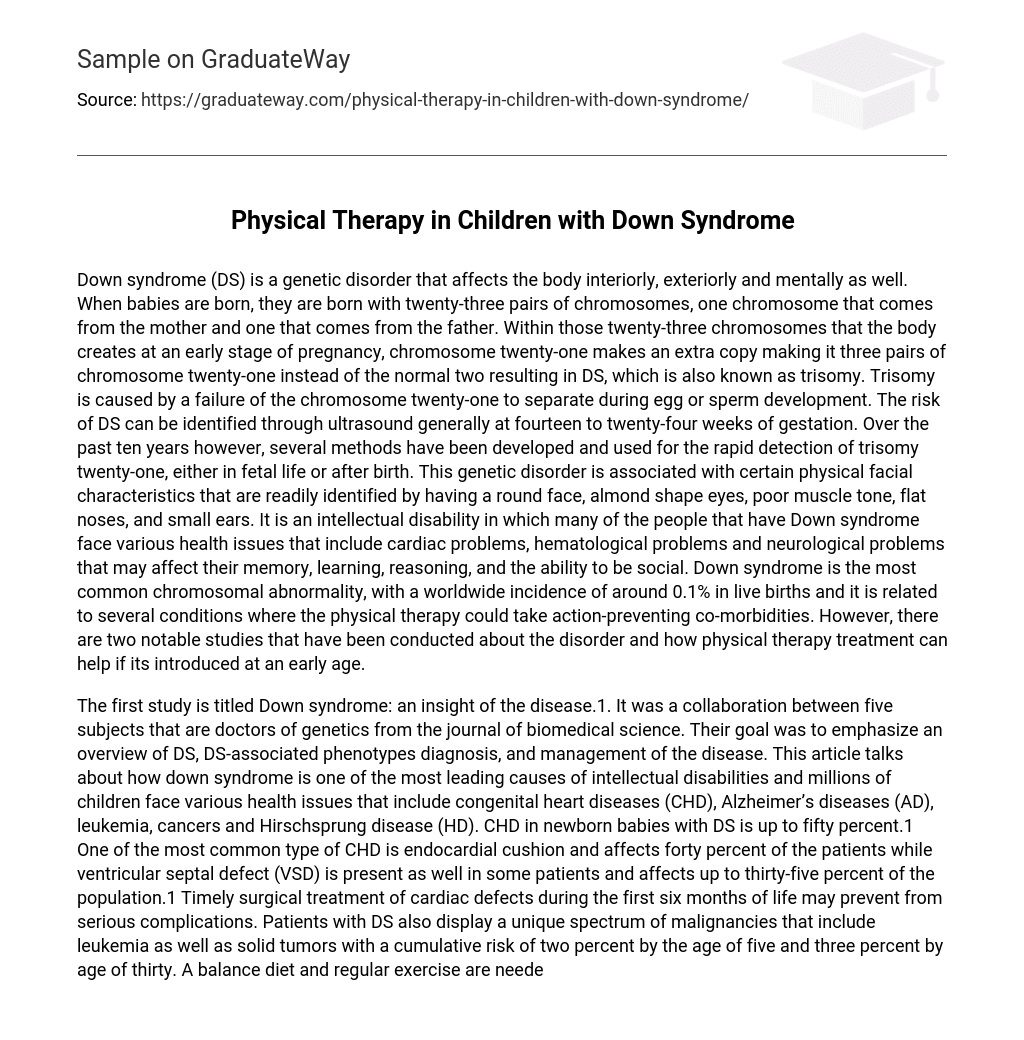Down syndrome (DS) is a genetic disorder that affects the body interiorly, exteriorly and mentally as well. When babies are born, they are born with twenty-three pairs of chromosomes, one chromosome that comes from the mother and one that comes from the father. Within those twenty-three chromosomes that the body creates at an early stage of pregnancy, chromosome twenty-one makes an extra copy making it three pairs of chromosome twenty-one instead of the normal two resulting in DS, which is also known as trisomy. Trisomy is caused by a failure of the chromosome twenty-one to separate during egg or sperm development. The risk of DS can be identified through ultrasound generally at fourteen to twenty-four weeks of gestation. Over the past ten years however, several methods have been developed and used for the rapid detection of trisomy twenty-one, either in fetal life or after birth. This genetic disorder is associated with certain physical facial characteristics that are readily identified by having a round face, almond shape eyes, poor muscle tone, flat noses, and small ears. It is an intellectual disability in which many of the people that have Down syndrome face various health issues that include cardiac problems, hematological problems and neurological problems that may affect their memory, learning, reasoning, and the ability to be social. Down syndrome is the most common chromosomal abnormality, with a worldwide incidence of around 0.1% in live births and it is related to several conditions where the physical therapy could take action-preventing co-morbidities. However, there are two notable studies that have been conducted about the disorder and how physical therapy treatment can help if its introduced at an early age.
The first study is titled Down syndrome: an insight of the disease.1. It was a collaboration between five subjects that are doctors of genetics from the journal of biomedical science. Their goal was to emphasize an overview of DS, DS-associated phenotypes diagnosis, and management of the disease. This article talks about how down syndrome is one of the most leading causes of intellectual disabilities and millions of children face various health issues that include congenital heart diseases (CHD), Alzheimer’s diseases (AD), leukemia, cancers and Hirschsprung disease (HD). CHD in newborn babies with DS is up to fifty percent.1 One of the most common type of CHD is endocardial cushion and affects forty percent of the patients while ventricular septal defect (VSD) is present as well in some patients and affects up to thirty-five percent of the population.1 Timely surgical treatment of cardiac defects during the first six months of life may prevent from serious complications. Patients with DS also display a unique spectrum of malignancies that include leukemia as well as solid tumors with a cumulative risk of two percent by the age of five and three percent by age of thirty. A balance diet and regular exercise are needed to maintain appropriate weight. It is noted in this article that recent advancement in medical treatment with social support has increased the life expectancy for DS population and prevention of DS depends upon offering prenatal diagnosis to high risk pregnancies.1 One of the hallmarks of DS is the variability in the way that the condition affects people with DS, meaning that not every person with DS has the same problems. Parents of children with DS should be aware of these possible conditions so that they can be diagnosed, treated quickly and appropriately because knowing how to facilitate the child’s learning will be critical to their success in collaborating with the child throughout his or her lifetime as they learn best through a gradual process.
The second study is titled Physical therapy in Down syndrome: systematic review and meta-analysis. It was a collaboration between different
References
- Asim A, Kumar A, Muthuswamy S, Jain S, Agarwal S. “Down syndrome: an insight of the disease.” Journal of Biomedical Science. 2015;22(1). doi:10.1186/s12929-015-0138-y.
- Ruiz-González L, Lucena-Antón D, Salazar A, Martín-Valero R, Moral-Munoz JA. Physical therapy in Down syndrome: systematic review and meta-analysis. Journal of Intellectual Disability Research. 2019;63(8):1041-1067. doi:10.1111/jir.12606.





